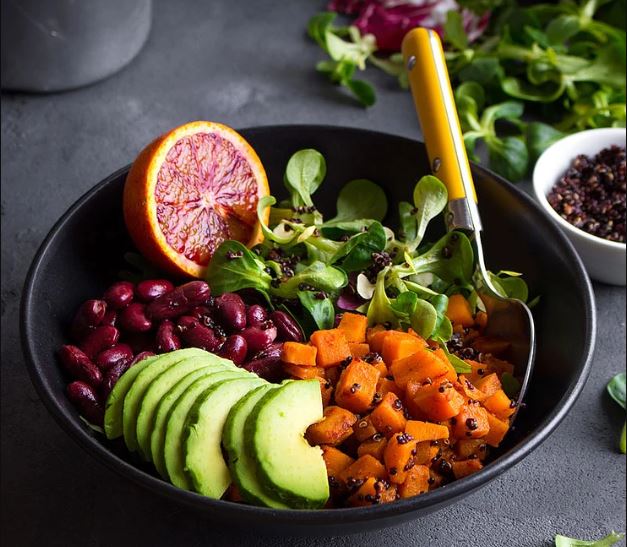Does having diabetes mean you can never have dessert again?! I don’t know about you, but when I was child there were always a separate belly for dessert. I may not have been able to finish my dinner, but the belly dessert was still empty! Lucky for me, my mom was a pushover, and she usually obliged me. Well not much has changed into my adult life, but would that all come to an end if I was diagnosed with diabetes? Here’s the basics on what you can and what you can’t eat.
The Down (to eat) – Foods you can Indulge
1. Grains/starches
Focus on eating whole grains whenever possible. Look for these words on the label to ensure you are getting the best fuel for your body. Whole grains contain fiber that can help with metabolizing fat and keeping the digestive track healthy. Some superfoods in this category include whole wheat (preferable stone-ground), barley, lentils and quinoa.
2. Vegetables
Vegetables should be the majority portion of your diabetic diet. They can be divided into starchy and non starchy vegetables. Starchy vegetables are great sources of vitamins, minerals and fiber, however they do have an effect on blood glucose levels. Foods like potatoes, corn, butternut or acorn squash and green peas are the best choices for healthy carbs. Non-starchy vegetable include broccoli, carrots, green beans, peppers, cauliflower, cucumber, beets and celery. These vegetables have a very low GI (Glycemic Index), meaning they do not cause a spike in your blood sugar. In addition, they are also good for you, so you can eat these to your heart’s content. Some superfoods in this category include dark leafy vegetables like kale, spinach and collard greens, but also the starchy sweet potato.
3. Fruits
Many people feel like fruits are off limits for diabetics, however fruits are loaded with vitamins, minerals and fiber just like vegetables. Fruit does contain carbohydrates, however most fruits have a low glycemic index (GI) because of their fructose and fiber content. A few good choices in this category consist of apples, avocados, banana, cherries and kiwi. Overall, fruit is encouraged when using the glycemic index to guide food choices—so enjoy. Some superfoods in this category include tomatoes, berries and citrus fruits.
4. Meats/Proteins
Protein helps keep blood sugar levels stable and keeps you feeling full, which can be a big bonus when trying to shed a few pounds. Protein is important for maintaining muscle mass and the immune system, and when paired with a carbohydrate, it helps control the release of the carbohydrate. When you’re on the hunt for a healthy protein to add to your plate, go ahead and think outside the red-meat section. Look for sources that are low in saturated fats yet rich in healthy fats like omega-3 fatty acids. Choose from fish ad seafood, plant proteins, and poultry to keep your menu fresh and your diet healthy. Some superfoods in this category are comprised of fish such as wild salmon, herring, mackerel and beans such as black, kidney and soy beans.
5. Dairy and alternatives
Including sources of dairy in your meal plan is a great way to get calcium and high-quality protein. The healthiest choices of dairy products are fat-free or low-fat milk, yogurt , cottage cheese and some reduced fat cheeses. Look for options that are organic or grass-fed to optimize the fatty profile. If you are lactose intolerant or don’t like milk, you may want to try fortified soy milk, rice milk, or almond milk as a source of calcium and vitamin D. Some superfoods in this category are unsweetened greek yogurt and dark chocolate.
The Dirty – Foods you Should Limit
1. Sugar-laden drinks
Sugars contain carbs that have a significant effect on your blood sugar. This is because they are broken down into sugar, or glucose, and absorbed into your bloodstream causing spike and can lead to increased diabetic complications. Avoid regular soda, sports and energy drinks, sweetened tea, lemonade and juice. Drink water instead of sweetened beverages. Consider using a sugar substitute in your coffee or tea.
2. White breads, rice and pasta
Refined carbohydrates are starches that have undergone processing which removes the bran and germ of the grain, stripping them of fiber, vitamins, minerals, and antioxidants. These foods can also cause big blood sugar spikes and yield little to no nutritional value. starches are high in carbs yet low in fiber. This combination can result in high blood sugar levels. Avoid white bread, pasta and rice and substitute with whole grain choices of these foods instead.
3. Margarine and Trans fat
The intent of margarine is to reduce saturated fat and calories. However, some margarine spreads are made with partially hydrogenated oil (trans fat). Avoid trans fat because it acts similarly to saturated fat. Aim to spread with heart-healthy fat alternatives like hummus, avocado, nut butter and use olive oil, sunflower oil and grapeseed oil for cooking. When planning your meals, it is best to eliminate all fried food from your diet.

The key to eating with diabetes is to eat a variety of healthy foods from all food groups, in the amounts suggested by your physician, dietician or nutritionist. The use of the plate method or the carb counting method will assist you in keeping your proportions in check and ensuring that your blood sugars remain stable.
The information you need . . straight up!

